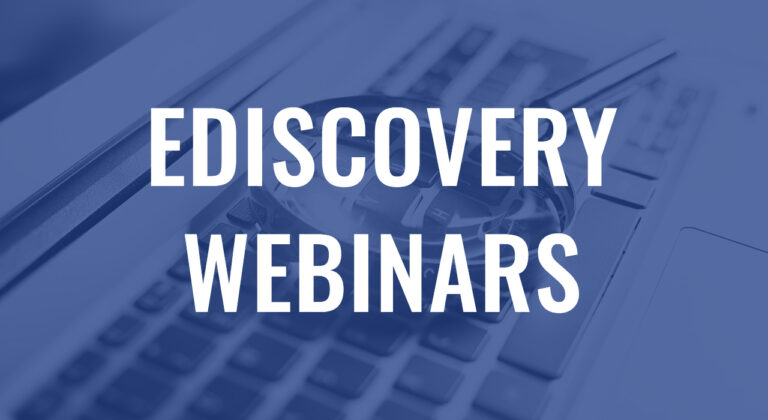
How Litigation Timelining Shifts the Playing Field to Your Advantage
As the volume of discoverable data continues to increase and data sources fragment, creating functional fact and issue timelines is more important than ever.

As the volume of discoverable data continues to increase and data sources fragment, creating functional fact and issue timelines is more important than ever.

With the exponential increase in data sources and increasingly tech savvy custodians, digital forensics has quickly come to the forefront in order to identify and collect the evidence required for your cases.

Preventing the inadvertent disclosure of privileged information in litigation is an increasing challenge. Technological advancements have ushered in varying mediums of information storage and exchange that thoroughly document privileged communications. This requires additional review resources to protect confidentiality and privilege.

The promise of high utility applications in the eDiscovery space, particularly AI, has opened up new possibilities and fueled expectations about the speed, accuracy and efficiency of performing evidentiary review.

Increasingly, non-email communications make up critical evidence in modern litigation. Text messaging and social media are used regularly by case participants and witnesses in addition to traditional email.

Using data maps in custodian interviews is an instrumental step to help locate evidence early in the case and establish leverage for building your best

eDiscovery is continuously evolving with each new year adding layers of complexity. Beyond the exponential year-over-year growth of Electronically Stored Information (ESI), the sources of ESI continue to diversify. Attorneys failing to stay up to date on the quickly evolving landscape risk missing evidence, wasting money and losing cases. This webinar provides an overview of the new and emerging challenges lawyers will face in 2020 as well as describing solutions for those willing to stay ahead of the curve.

Increasingly lawyers are taking advantage of technology to practice in specialized boutique and smaller firm environments. But the rapidly growing size of collections of electronically stored information (ESI) presents an increasingly difficult challenge: How to effectively manage these resource-hungry cases without large firm support?

Plaintiffs face unique challenges when conducting discovery. A central difference is asynchronous data; plaintiffs must focus on accessing often complex document collections in the hands of defendants and third parties. More data to review and more complicated data types increasingly can overwhelm how attorneys traditionally have requested and reviewed productions and marshaled evidence.

Plaintiffs face unique challenges when conducting discovery. A central difference is asynchronous data; plaintiffs must focus on accessing often complex document collections in the hands of defendants and third parties. More data to review and more complicated data types increasingly can overwhelm how attorneys traditionally have requested and reviewed productions and marshaled evidence.

Email communications continue to play a big role in eDiscovery and have contained critical evidence in support of malpractice claims. Join us for this informative session where you’ll learn the seven deadly sins of email as well as best practices to help you avoid malpractice claims. You’ll also learn how to use the seven deadly sins of email in discovery to help you identify evidence in document review.

The proliferation of ESI sources requires an approach that expands beyond email. Understanding the IT profile of the custodian and utilizing a data map is instrumental in identifying the key sources of ESI. The growth in apps, collaboration platforms, cloud storage and the Internet of Things (IoT) devices has resulted in the exponential growth in quantity and complexity of ESI sources.

With the exponential growth of data on the internet, the Internet Archive Wayback Machine (IAWM) has emerged as a critical source of evidence in legal cases. During this session, you’ll hear from an expert witness on the IAWM and it’s use in litigation. You’ll learn about the background of the IAWM, examples of it’s use in specific cases, the interface and features, authentication and admissibility, temporal coherence, and timestamping of content changes. By viewing this session, you’ll learn how to utilize the IAWM for your cases.

During this highly informative session you’ll learn the top tips for improving your eDiscovery project management. You’ll hear examples of how not adopting these best practices has resulted in embarrassing eDiscovery failures.

https://lexbe.com/wp-content/uploads/2023/05/AI-in-eDiscovery.mp4By Karsten Weber, CTO at Lexbe With all the talk about Artificial Intelligence (AI) in the media and how ChatGPT passed the Uniform Bar Examination

There are few industries that have evolved as rapidly as eDiscovery. With companies and people adopting new technology to deal with the pandemic, as well as digital transformation, the sources and scope of data in litigation has grown significantly.

During this episode of Lexbe’s webinar series on best practices in eDiscovery, you’ll hear from three industry experts on how to structure and execute a successful document review.

Using data maps in custodian interviews is an instrumental step to help locate evidence early in the case and establish leverage for building your best argument.

With the pandemic prompting more than 40% of workers to consider quitting their jobs or changing careers, many law firms continue to scramble to find and secure talent.

Learn critical evidentiary insights into smartphones as utilization skyrocketed due to the pandemic and their role in eDiscovery continues to grow.

With billions of active users, file sharing, and multi-channel messaging capabilities, social media has rapidly ascended to the top of evidentiary electronically stored information (ESI) for many cases.

As the volume of discoverable data continues to increase and data sources fragment, creating functional fact and issue timelines is more important than ever.
To schedule a personal demo, get a price quote, or free consultation, please complete this form below and one of our expert sales professionals will contact you. If you prefer, you can contact us directly at 1-800-401-7809 x22 or at [email protected].
All contact information is kept confidential. View our privacy policy.